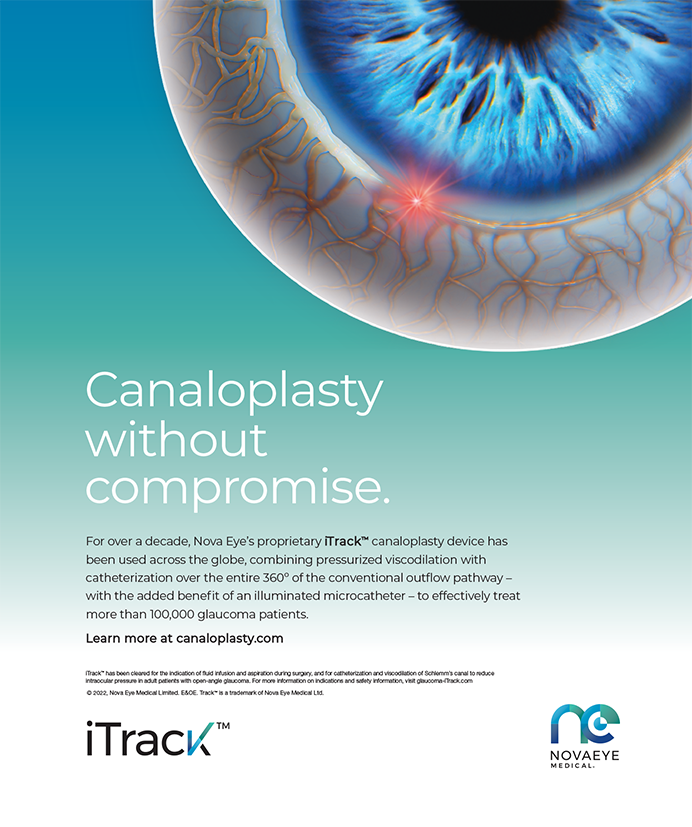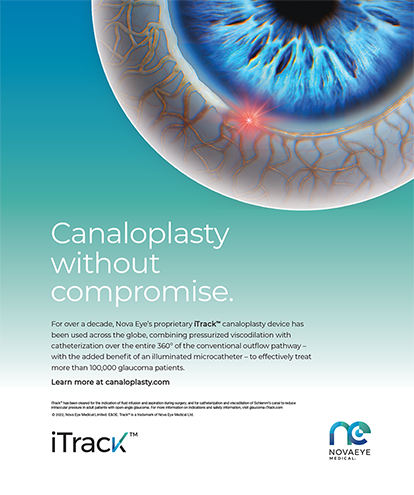When examining the subject of mixing and matching IOLs, one must first review the proposed benefits and downsides of each approach. This article discusses why I feel mixing multifocal IOLs does not produce a greater percentage of happy patients and, in the long run, is likely to make more patients unhappy. Patients are most pleased following multifocal IOL surgery if they can function normally on a day-to-day basis with minimal dependence on spectacles.
NIGHTTIME VISUAL DISTURBANCES
One of the reasons why I prefer the AcrySof Restor multifocal IOL platform (Alcon Laboratories, Inc., Fort Worth, TX) is that I have found it produces fewer difficulties with nighttime glare and halos than the ReZoom zonal refractive IOL (Advanced Medical Optics, Inc., Santa Ana, CA). In early 2007, I presented a poster at the ASCRS meeting describing the results of an optical bench evaluation of nighttime visual symptoms with various multifocal IOLs.1 I found the least distortion with the AcrySof Restor platform (Figure 1). Similarly, for a poster presented at the 2007 ESCRS meeting, investigators analyzed visual disturbances in a simulated night-driving environment.2 They found the fewest visual disturbances with the AcrySof Restor platform (Figure 2). Obviously, in order to justify placing a ReZoom IOL in a fellow eye, the surgeon must feel that the known disadvantage of nighttime dysphotopsia will be offset by a significant improvement for the patient in another parameter of visual function.
INTERMEDIATE VISION
Proponents of mixing other IOLs with the AcrySof Restor platform propose that doing so improves patients' intermediate vision without any disadvantages, because their brains adjust to improve the image.3
My patients rarely report significant midrange visual problems after the bilateral implantation of the AcrySof Restor IOL. Their experience may be explained by several factors. First, preoperative counseling is critical to my success with multifocal IOLs. I inform patients that this lens technology entails a bilateral procedure and that they will see best once they receive their second implant. Second, I explain to patients that their vision will improve with both bilateral summation and neuroadaption, which take time. Third, I show patients where their near visual point will be immediately after surgery. I actually move their hands approximately 12 to 14 inches from their faces and say, "Early on, this is where you will see best up close. Over time, your vision will push outward." It is important for patients to understand this phenomenon preoperatively so they will be comfortable postoperatively. Finally, I address midrange vision by telling patients that the AcrySof Restor lens' design has one peak for reading up close and one for distance and emphasize that the IOL is not quite as strong?but is still functional?in the midrange.
Data from other clinicians also demonstrate that the midrange "difficulties" of the AcrySof Restor lens have been overestimated. In a prospective study of patients who received the AcrySof Restor or ReZoom IOL bilaterally and in a retrospective study of patients who received the Crystalens accommodating IOL (Eyeonics, Inc., Aliso Viejo, CA) bilaterally, David Chang, MD, found that the AcrySof Restor group had the strongest midrange vision when tested through their best distance correction to produce an emmetropic eye.4
Another study reviewed the data from a group of ophthalmologists that included Robert Cionni, MD; Stephen Lane, MD; Eric Donnenfeld, MD; Kerry Solomon, MD; James McCulley, MD; and Dr. Chang.5 This study included more than 150 patients who had received the AcrySof Restor IOL bilaterally at least 6 months earlier. The investigators found that the patients had an extremely high degree of satisfaction with their overall visual function for distance, intermediate, and near vision. When asked specifically about their use of computers, the patients again reported a high degree of satisfaction.
INTERMEDIATE VISION: OBSERVATIONS VERSUS COMPLAINTS
How do I reconcile my positive experiences with those of colleagues who have been concerned about intermediate vision with the AcrySof Restor lens? The issue may be one of observations versus complaints. For ophthalmologists, cataract surgery is routine, but it is a unique experience for patients. They may voice numerous questions or observations out of a desire for reassurance. For example, many of my patients mention that their eyes feel scratchy postoperatively. They are not complaining but are asking if the sensation is normal. Once they hear it is, they are usually relieved.
Similarly, after receiving the AcrySof Restor IOL, those of my patients who make observations regarding their midrange vision have the sharpest overall vision (eg, 20/20, J1). Their vision is so strong at distance and near that they often notice the drop-off at midrange. They will often ask why their midrange vision is less clear. Because I understand that this is usually an observation rather than a complaint, I will answer that the phenomenon is normal. I also remind them of our preoperative discussion, during which I explained that, initially, they would see best at near and distance but that their midrange vision would improve over time. These patients usually confirm remembering this discussion.
STUDIES EVALUATING MIXING
Richard Mackool, MD, performed a prospective study of mixing multifocal IOLs. His series consisted of 15 consecutive patients (13 undergoing cataract surgery and two undergoing refractive lens exchange for hyperopia) who received an AcrySof Restor IOL in one eye and a ReZoom IOL in the other.6 He asked patients which eye they preferred for distance, intermediate, and near vision and asked them to rate the overall quality of their vision. There was no difference between either lens' objectively measured or subjectively perceived distance acuity postoperatively. Nearly all of the patients preferred their AcrySof Restor eye for near, however, and many favored their ReZoom eye for intermediate vision. One patient requested to have his ReZoom lens removed because of poor distance, near, and intermediate vision, and four patients (including the two refractive lens exchange patients) insisted on having this lens explanted because of poor near vision. Two of these patients listed the symptoms of nocturnal glare and halos as an additional reason for explantation. No patient requested the removal of an AcrySof Restor lens, and all patients who had their ReZoom lens explanted were happy with bilateral AcrySof Restor IOLs.
Dr. Solomon and colleagues also conducted a prospective, randomized study on mixing and matching multifocal IOL platforms.7 He found that the subjects who received two AcrySof Restor lenses had the best overall reading and near vision, the best visual summation, and the fewest nighttime vision symptoms at 3 and 6 months. Mixing and a Blaylock approach (the bilateral implantation of the AcrySof Restor lens with a planned myopic result of approximately 1.00 D in the nondominant eye)8 provided a better range of vision but at the expense of near vision and night vision symptoms.
Paul Mann, MD, and colleagues evaluated his personal experience with 205 patients who received presbyopia-correcting IOLs (32 received the Crystalens bilaterally, 82 received the AcrySof Restor lens bilaterally, 49 received the ReZoom IOL bilaterally, and 42 received an AcrySof Restor lens in one eye and a ReZoom IOL in their fellow eye).9 For more on his results, read Dr. Mann's article on page 69. To summarize, most patients were pleased with their outcomes. Moreover, there were clear data that mixing the AcrySof Restor and ReZoom lenses did not yield higher levels of spectacle independence than the bilateral implantation of either IOL.
Nonetheless, a few physicians have reported better results from mixing the AcrySof Restor and ReZoom IOLs than implanting them bilaterally. I cannot reconcile these clinical findings with either my own clinical experience or that of the physicians I have mentioned. Perhaps these patients and physicians have lower expectations. I have actually seen a number patients with mixed IOLs and have documented for my files their unhappiness with this approach.
SUMMARY
It is possible to make patients happy with any of the presbyopia-correcting IOLs or a combination thereof. Without question, each lens has its strengths and weaknesses, and some of the variance in different investigators' results may represent differences in how they counsel and manage their patients. Each physician needs to evaluate the benefits of these technologies objectively and decide on the most reasonable approach.
I believe, however, that a careful review of the objective data available clearly shows that the bilateral implantation of the AcrySof Restor IOL will produce the greatest percentage of happy patients and, more importantly, the least likelihood of significant clinical problems. With the imminent release of the aspheric AcrySof Restor platform, it is likely that the rationale for implanting this lens bilaterally will be even stronger.
Richard Tipperman, MD, is a member of the active teaching staff at Wills Eye Hospital in Philadelphia. He is a consultant to Alcon Laboratories, Inc. Dr. Tipperman may be reached at (484) 434-2716; rtipperman@mindspring.com.


